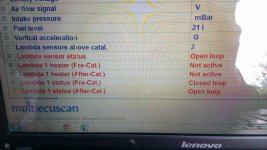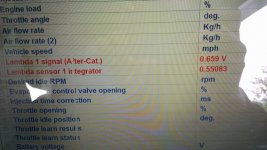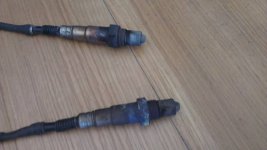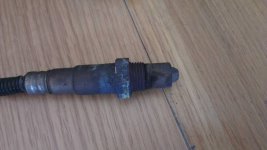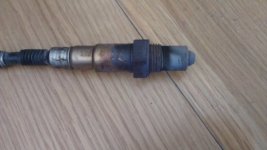Hi, got recurring code of P1135, was just wondering what values and data should be looking out for on multiecuscan when monitoring the lambdas (what range of values, voltages etc)?
You are using an out of date browser. It may not display this or other websites correctly.
You should upgrade or use an alternative browser.
You should upgrade or use an alternative browser.
Technical P1135 - what to look for on MES
- Thread starter KRaikkonenNo1
- Start date
Currently reading:
Technical P1135 - what to look for on MES
- Joined
- Mar 13, 2011
- Messages
- 7,620
- Points
- 1,453
why?
mes clearly shows heater not working
if you have another lambda after cat and it will come out swap them round if you dont want to spend money at this stage to prove heaters gone down
do not buy a chep new lambda they dont work efficiently enough
The values shown in the pictures are with the engine off, not with it running though. I was just wondering what they should be saying,
Just to note the error code I got was for the pre-cat lambda
rocky420
Banned
do what s and b says never buy cheap lambda sensors  i know a friend that did this, i did warn him not to but could call it being stubborn :bang: through one end out the other and it didnt last long whatsoever
i know a friend that did this, i did warn him not to but could call it being stubborn :bang: through one end out the other and it didnt last long whatsoever 
What do you guys class as 'cheap' lambdas? Ecp have a Bosch one for £33? Eurocarcare seem to be out of stock atm
rocky420
Banned
i mainly go andrew page for parts for customers as they tend to do quality parts  give them a try.
give them a try.
Cheers guys, will get looking for lambda sensor -- will try use forum retailers :thumbup:
Forgot to upload this little vid earlier of the monitoring of the lambdas -- does that look good or bad from the video?
Also to note the image is before the car was turned on and in the video the car had been idling for 5mins.
What I have noticed tho is that the lambda 1 status (pre cat) was always closed loop and it was never open loop like I thought it should be, could someone clarify this for me?
Thanks!
[ame]http://youtu.be/LY3TRu3EKIQ[/ame]
Forgot to upload this little vid earlier of the monitoring of the lambdas -- does that look good or bad from the video?
Also to note the image is before the car was turned on and in the video the car had been idling for 5mins.
What I have noticed tho is that the lambda 1 status (pre cat) was always closed loop and it was never open loop like I thought it should be, could someone clarify this for me?
Thanks!
[ame]http://youtu.be/LY3TRu3EKIQ[/ame]
Attachments
- Joined
- Apr 8, 2008
- Messages
- 16,742
- Points
- 3,187
To start with - do you know what Open and Closed Loop is?
A Lambda sensor upon first start up will give a reading as it always will
But the ECU goes thank you very much - scrunches it up and throws it away
This is OPEN loop - the car see's the information but doesn't react to it
When the Engine is warming up - according to the Engine temp sensor
the Sensor then goes into CLOSED LOOP
Closed loop is when the car starts to listen to what the lamba sensor is saying
For example
The Lambda says - Mixture tooo lean
ECU goes - Okay - open injectors a little longer to make it more rich
Lambda says WOAH - to rich now
ECU goes = okay - shut the injectors time down a little
Lambda then goes thats better but still a little rich
So ECU goes - okay - shut injectors time off some more
Lambda says - WOAH too lean again
Hence when you look a PRECAT sensor reading it peaks and troughs as the mixture goes lean then rich then lean
I remember it as this - Righ is High (voltage) lean is low (voltage)
The car is always aiming for something called
stoichiometric ratio - in laymans terms, the PERFECT burn, 14.7 parts of air to 1 part fuel
A perfect burn is also called Lambda 1 along with many other names
So when a sensor is in closed loop - it means its working to a degree
A scope or voltage graph reading which MES can do will help tell if the sensor is giving a true reading
The preheater is just a coil - a simple Ohms test is all thats needed here
Ziggy
A Lambda sensor upon first start up will give a reading as it always will
But the ECU goes thank you very much - scrunches it up and throws it away
This is OPEN loop - the car see's the information but doesn't react to it
When the Engine is warming up - according to the Engine temp sensor
the Sensor then goes into CLOSED LOOP
Closed loop is when the car starts to listen to what the lamba sensor is saying
For example
The Lambda says - Mixture tooo lean
ECU goes - Okay - open injectors a little longer to make it more rich
Lambda says WOAH - to rich now
ECU goes = okay - shut the injectors time down a little
Lambda then goes thats better but still a little rich
So ECU goes - okay - shut injectors time off some more
Lambda says - WOAH too lean again
Hence when you look a PRECAT sensor reading it peaks and troughs as the mixture goes lean then rich then lean
I remember it as this - Righ is High (voltage) lean is low (voltage)
The car is always aiming for something called
stoichiometric ratio - in laymans terms, the PERFECT burn, 14.7 parts of air to 1 part fuel
A perfect burn is also called Lambda 1 along with many other names
So when a sensor is in closed loop - it means its working to a degree
A scope or voltage graph reading which MES can do will help tell if the sensor is giving a true reading
The preheater is just a coil - a simple Ohms test is all thats needed here
Ziggy
To start with - do you know what Open and Closed Loop is?
A Lambda sensor upon first start up will give a reading as it always will
But the ECU goes thank you very much - scrunches it up and throws it away
This is OPEN loop - the car see's the information but doesn't react to it
When the Engine is warming up - according to the Engine temp sensor
the Sensor then goes into CLOSED LOOP
Closed loop is when the car starts to listen to what the lamba sensor is saying
For example
The Lambda says - Mixture tooo lean
ECU goes - Okay - open injectors a little longer to make it more rich
Lambda says WOAH - to rich now
ECU goes = okay - shut the injectors time down a little
Lambda then goes thats better but still a little rich
So ECU goes - okay - shut injectors time off some more
Lambda says - WOAH too lean again
Hence when you look a PRECAT sensor reading it peaks and troughs as the mixture goes lean then rich then lean
I remember it as this - Righ is High (voltage) lean is low (voltage)
The car is always aiming for something called
stoichiometric ratio - in laymans terms, the PERFECT burn, 14.7 parts of air to 1 part fuel
A perfect burn is also called Lambda 1 along with many other names
So when a sensor is in closed loop - it means its working to a degree
A scope or voltage graph reading which MES can do will help tell if the sensor is giving a true reading
The preheater is just a coil - a simple Ohms test is all thats needed here
Ziggy
Thanks for the detailed reply!
I have a good idea what open and closed loop is, from what I originally understood both lambdas usually start in open loop until heated up then pre cat lambda should fluctuate from low to high (0.20v to 0.80v) etc, etc -- your explanation says all that's needed to be said, I understand this part :thumbup:
What I'm not so clear on is how to properly test via MES. I know on my previous 8v punto that MES gave voltage readings for the lambdas but for my 16v it doesn't appear that voltage readings are given? (correct me if I'm totally wrong!)
Finally, I only have a very rough idea of how to test the preheater, could you possibly expand on how to?
Appreciated!
- Joined
- Apr 8, 2008
- Messages
- 16,742
- Points
- 3,187
Testing a pre heater is simple
Disconnect the lambda sensor
2 wires are for the "heater" which is just a coil
Auto data states the Pins 3 and 4 are the coil
You should have a reading of 10 Ohms for 8v
4 - 11ohms on a 16v which is abit wide IMO
Simply put your multi-meter on pin 3 and 4
If the preheater is too resistive or open circuit, it'll throw up error codes
its a 30second test from disconnecting the harness - probing - reading - reconnecting
Ziggy
Disconnect the lambda sensor
2 wires are for the "heater" which is just a coil
Auto data states the Pins 3 and 4 are the coil
You should have a reading of 10 Ohms for 8v
4 - 11ohms on a 16v which is abit wide IMO
Simply put your multi-meter on pin 3 and 4
If the preheater is too resistive or open circuit, it'll throw up error codes
its a 30second test from disconnecting the harness - probing - reading - reconnecting
Ziggy
Testing a pre heater is simple
Disconnect the lambda sensor
2 wires are for the "heater" which is just a coil
Auto data states the Pins 3 and 4 are the coil
You should have a reading of 10 Ohms for 8v
4 - 11ohms on a 16v which is abit wide IMO
Simply put your multi-meter on pin 3 and 4
If the preheater is too resistive or open circuit, it'll throw up error codes
its a 30second test from disconnecting the harness - probing - reading - reconnecting
Ziggy
Both pre and post lambdas heater come back with 9.4 ohms, so that's fine..but it is not the preheating that I suspect is the issue, so I've swapped them both round to see if the code changes to post cat rather than pre cat.
Both lambdas look pretty sorry for themselves, with the post cat having dried coolant on on the outside and the pre cat lambda looking like it has been spray painted on the sensor (pre cat is suspected failure, post cat appears fine)
Thanks
Attachments
Similar threads
- Replies
- 0
- Views
- 166
- Replies
- 2
- Views
- 659


